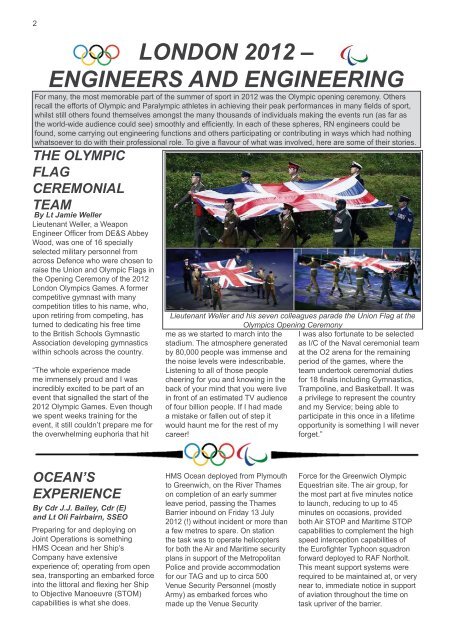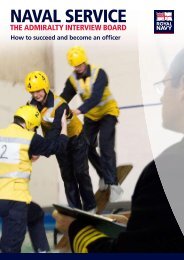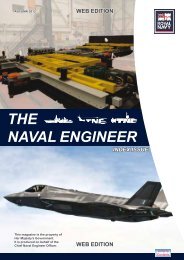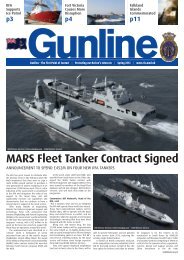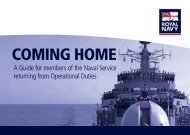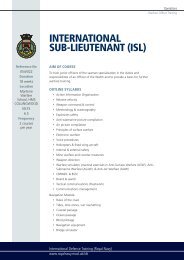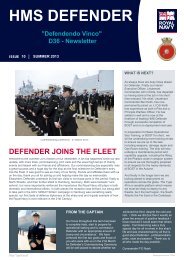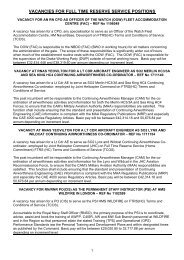THE NAVAL ENGINEER
THE NAVAL ENGINEER
THE NAVAL ENGINEER
Create successful ePaper yourself
Turn your PDF publications into a flip-book with our unique Google optimized e-Paper software.
2<br />
London 2012 –<br />
Engineers and Engineering<br />
For many, the most memorable part of the summer of sport in 2012 was the Olympic opening ceremony. Others<br />
recall the efforts of Olympic and Paralympic athletes in achieving their peak performances in many fields of sport,<br />
whilst still others found themselves amongst the many thousands of individuals making the events run (as far as<br />
the world-wide audience could see) smoothly and efficiently. In each of these spheres, RN engineers could be<br />
found, some carrying out engineering functions and others participating or contributing in ways which had nothing<br />
whatsoever to do with their professional role. To give a flavour of what was involved, here are some of their stories.<br />
The Olympic<br />
Flag<br />
Ceremonial<br />
Team<br />
By Lt Jamie Weller<br />
Lieutenant Weller, a Weapon<br />
Engineer Officer from DE&S Abbey<br />
Wood, was one of 16 specially<br />
selected military personnel from<br />
across Defence who were chosen to<br />
raise the Union and Olympic Flags in<br />
the Opening Ceremony of the 2012<br />
London Olympics Games. A former<br />
competitive gymnast with many<br />
competition titles to his name, who,<br />
upon retiring from competing, has<br />
turned to dedicating his free time<br />
to the British Schools Gymnastic<br />
Association developing gymnastics<br />
within schools across the country.<br />
“The whole experience made<br />
me immensely proud and I was<br />
incredibly excited to be part of an<br />
event that signalled the start of the<br />
2012 Olympic Games. Even though<br />
we spent weeks training for the<br />
event, it still couldn’t prepare me for<br />
the overwhelming euphoria that hit<br />
Lieutenant Weller and his seven colleagues parade the Union Flag at the<br />
Olympics Opening Ceremony<br />
me as we started to march into the I was also fortunate to be selected<br />
stadium. The atmosphere generated as I/C of the Naval ceremonial team<br />
by 80,000 people was immense and at the O2 arena for the remaining<br />
the noise levels were indescribable. period of the games, where the<br />
Listening to all of those people team undertook ceremonial duties<br />
cheering for you and knowing in the for 18 finals including Gymnastics,<br />
back of your mind that you were live Trampoline, and Basketball. It was<br />
in front of an estimated TV audience a privilege to represent the country<br />
of four billion people. If I had made and my Service; being able to<br />
a mistake or fallen out of step it participate in this once in a lifetime<br />
would haunt me for the rest of my opportunity is something I will never<br />
career!<br />
forget.”<br />
Ocean’s<br />
Experience<br />
By Cdr J.J. Bailey, Cdr (E)<br />
and Lt Oli Fairbairn, SSEO<br />
Preparing for and deploying on<br />
Joint Operations is something<br />
HMS Ocean and her Ship’s<br />
Company have extensive<br />
experience of; operating from open<br />
sea, transporting an embarked force<br />
into the littoral and flexing her Ship<br />
to Objective Manoeuvre (STOM)<br />
capabilities is what she does.<br />
HMS Ocean deployed from Plymouth<br />
to Greenwich, on the River Thames<br />
on completion of an early summer<br />
leave period, passing the Thames<br />
Barrier inbound on Friday 13 July<br />
2012 (!) without incident or more than<br />
a few metres to spare. On station<br />
the task was to operate helicopters<br />
for both the Air and Maritime security<br />
plans in support of the Metropolitan<br />
Police and provide accommodation<br />
for our TAG and up to circa 500<br />
Venue Security Personnel (mostly<br />
Army) as embarked forces who<br />
made up the Venue Security<br />
Force for the Greenwich Olympic<br />
Equestrian site. The air group, for<br />
the most part at five minutes notice<br />
to launch, reducing to up to 45<br />
minutes on occasions, provided<br />
both Air STOP and Maritime STOP<br />
capabilities to complement the high<br />
speed interception capabilities of<br />
the Eurofighter Typhoon squadron<br />
forward deployed to RAF Northolt.<br />
This meant support systems were<br />
required to be maintained at, or very<br />
near to, immediate notice in support<br />
of aviation throughout the time on<br />
task upriver of the barrier.


